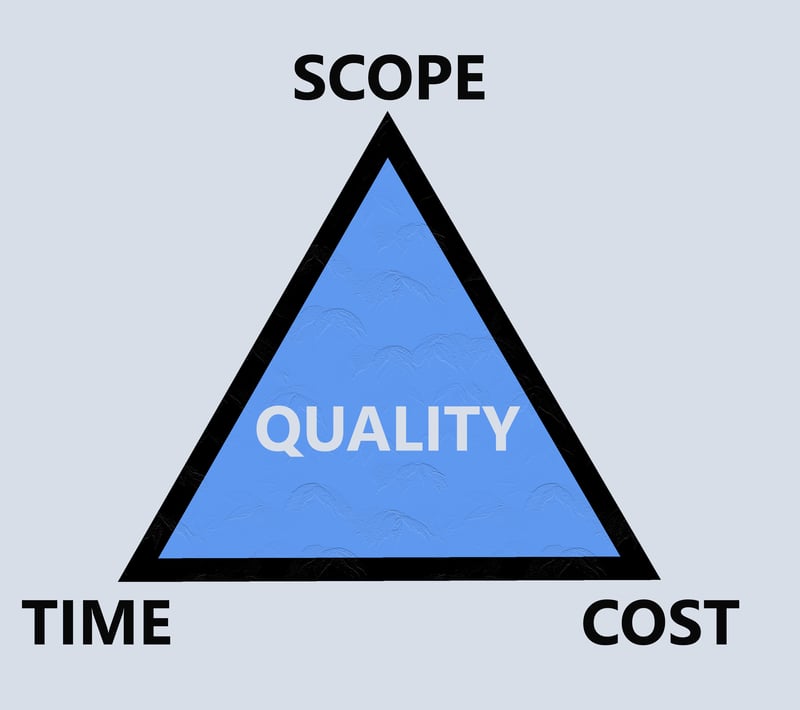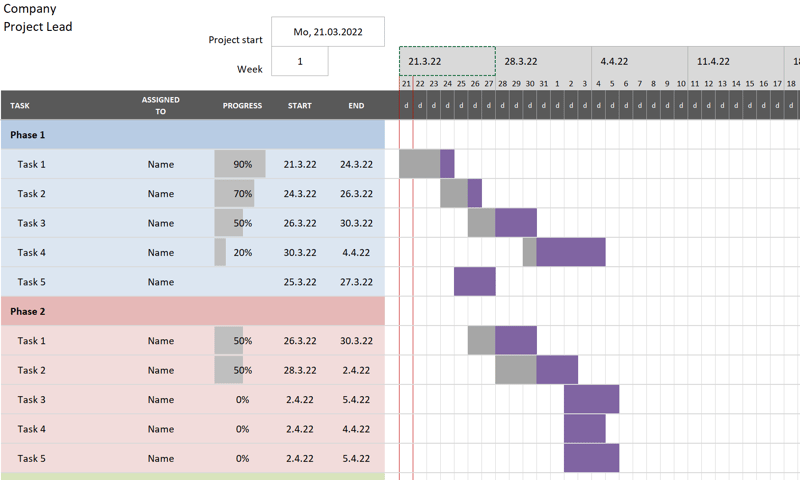Project Management Triangle – What Is It and What Does It Do?
For tricky projects, management teams sometimes wish for a bit of sorcery. The "magic triangle", which has nothing to do with wizardry, visualizes project dimensions and their interrelationships. So how does it work?
Imagine a project: Resources and time are rarely unlimited. A client would like a piece of software with certain capabilities, however, programming it is taking longer than expected and the costs are rising quickly.
Project managers must be able to balance the different dimensions and understand how they impact one another. In this article, we'll show you how the magic triangle helps to do this, as well as which factors play a role.
The Magic Triangle
The magic triangle is used in classic project management. The three factors that it visualizes, time, cost, and scope are known as dimensions and plotted at the triangle's corners.
Dimensions influence one another and are not isolated. Whenever one of them changes, it has a direct impact on either one or both of the other dimensions.

The magic triangle's three dimensions are time, cost, and scope.
Sometimes, the magic triangle is referred to as a "constraint triangle", since the dimensions limit one another. Project managers must balance the three factors, resolve conflicts, and steer the project toward success.
Some studies refer to a fourth dimension, which doesn't appear in the triangle but does not impact all of its factors: Customer satisfaction.
This also changes along with the standard parameters. Just consider the following: "Is it in the client's interest if their software is finished ahead of schedule, but doesn't meet all of their requirements?"
Talk of a fourth dimension is relatively new and emerged as businesses began to pay greater attention to their customers's needs and wants. This dimension was not included in the original magic triangle concept.
The Three Dimensions
We already mentioned the magic triangle's three dimensions, time, cost, and scope. Below, we'll go into a bit more detail about what each entails.
Time
This takes all factors of a project into account that can be measured in terms of time:
How much time does the project have?
When is the starting date and when should the project be finished?
Which key dates and releases are there?
Are they time-bound milestones?
By answering these and other questions, project managers can create a project schedule. Gantt charts use bars to show which activities occur when, and which milestones build upon one another.

This basic Gantt chart was created in Microsoft Excel.
When working with time, project managers must pay attention to key dates and deadlines.
Cost
Costs correlate to a project's budget and all of the means at its disposal. The project manager must be able to answer these questions:
What are the project's costs?
What sort of budget is available?
How many personnel, both external and internal, can be utilized?
Which material expenses are there?
Through resource planning, an overview of the costs, both financial and non-financial, can be computed. It's important for managers to regularly check a project's actual status against its nominal one throughout its course.
Scope
Scope refers to how much the project intends to achieve and can be determined by answering these questions:
What goal(s) does the project have?
How should targets be reached and what needs to be done to do so?
What properties does the result have and how comprehensive is it?
What are the project or service's specific requirements?
In essence, this dimension describes the project's performance. It entails everything that should be accomplished during a project and has a significant impact on its time and cost.
Usage Examples
In practice, project managers use the magic triangle when they hold preliminary discussions with clients.
The questions listed above help to make the three dimensions more tangible and to include all important and relevant information. This provides a good foundation to continue planning since it makes the project's goals clearer.
The magic triangle also provides a basis for regular project reports, which compare current and nominal status. Here, the magic triangle helps to easily visualize changes and compliance.
It's also useful for risk analysis since conflicts or tension between the dimensions reveal a project's risks at an early stage and allow for them to be addressed.
Another use is as a regulatory tool: If a dimension suddenly changes, the project's leaders will know that the other dimensions will be impacted as well. Proactive measures can then be taken with the other dimensions.
To demonstrate how the magic triangle works in practice, we prepared a few examples below.
Time vs. Cost
Conflict: The release date for a piece of software as well as its budget are fixed. However, there's been a delay and the deadline can no longer be met with the means available. The dimensions conflict with one another.
Potential solutions:
- 1.
The project's managers can adjust the time dimension by pushing it back and updating the project's plan.
- 2.
The project managers can allocate more internal personnel or hire external developers to help meet the deadline. This prioritizes the time dimension and requires changes to cost.
Cost vs. Scope
Conflict: A budget has been provided to develop a piece of software, however, it has almost been exhausted, and the project is not yet complete.
Potential solutions:
- 1.
The project's managers can stick to the original budget and modify its scope. The software's performance or appearance might be sacrificed to complete it within the agreed-upon budget.
- 2.
The project's managers decide to change the cost dimension to reach the original goal. This means that more resources will be invested to achieve the project's scope.
Scope vs. Time
Conflict: The project is nearing its deadline, however, there isn't enough time to include all of the capabilities that were originally planned. The time and scope dimensions conflict with one another.
Potential solutions:
- 1.
The project's managers decide to keep to the original deadline. This means that the software might not be as comprehensive as originally intended.
- 2.
The project's managers push the release date back in favor of its scope. Ensuring that the project provides everything that was planned requires the time dimension to be adjusted.
Conclusion
The magic triangle can be used to plan projects. It offers transparency and helps to visualize whether a project is proceeding according to schedule.
Since its dimensions impact and influence one another, the tool helps project managers quickly react to new developments. If one dimension suddenly changes, the other two can be adjusted to compensate for it.
This is best summarized with two basic examples: If time is short, either the budget needs to be increased, or the scope reduced. Should a project's scope increase, more time or a larger budget is necessary.
Project managers can use the magic triangle to identify risks early on and take proactive steps. This makes it a relatively straightforward tool for structuring projects and reacting to changes and unexpected developments.














